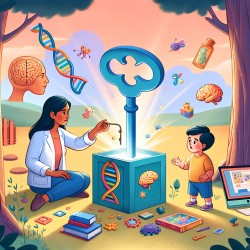Introduction
As a dedicated speech-language pathologist, your primary goal is to foster optimal communication outcomes for children. Recent research has unveiled intriguing insights into the role of early life exposures and their impact on neurodevelopmental disorders, which could revolutionize your practice. A study titled Early life exposures, neurodevelopmental disorders, and transposable elements sheds light on how environmental factors during early development influence brain health and susceptibility to disorders. Understanding these findings can empower you to make data-driven decisions that enhance therapeutic outcomes.
Understanding Transposable Elements
Transposable elements (TEs) are DNA sequences that can change positions within the genome. Surprisingly, they constitute about half of the human genome. While their role in protein-coding genes is not fully understood, TEs are increasingly recognized for their impact on brain development and adaptation to environmental stressors.
TEs are categorized into two main classes: DNA transposons and retrotransposons. Retrotransposons, which include LINEs and SINEs, are particularly active in the human genome. They can influence gene expression and contribute to genomic variability, potentially affecting individual susceptibility to environmental challenges.
Impact of Early Life Exposures
Early life is a critical period for brain development, during which TEs play a significant role. The study highlights how environmental exposures, such as stress, during this time can lead to abnormal regulation of TEs, increasing susceptibility to neurodevelopmental disorders later in life. This finding is crucial for practitioners working with children, as it underscores the importance of early intervention and environmental enrichment.
For instance, stress-induced activation of glucocorticoid receptors can regulate TEs in the brain, potentially leading to long-term changes in brain function. Understanding these mechanisms can help practitioners identify at-risk children and tailor interventions to mitigate negative outcomes.
Applications in Speech-Language Pathology
Integrating knowledge of TEs and early life exposures into your practice can enhance your ability to support children with neurodevelopmental disorders. Here are some practical applications:
- Early Screening: Incorporate assessments that evaluate environmental stressors and genetic factors to identify children at risk for communication disorders.
- Targeted Interventions: Design interventions that address specific environmental and genetic factors contributing to a child's condition, potentially improving therapeutic outcomes.
- Parental Education: Educate parents about the impact of early life exposures on brain development and the importance of creating a supportive environment for their children.
Encouraging Further Research
The study on TEs and early life exposures opens new avenues for research in speech-language pathology. By exploring the interplay between genetic and environmental factors, practitioners can develop more effective, personalized interventions for children with communication disorders. Collaborating with researchers and staying informed about emerging studies will ensure that your practice remains at the forefront of evidence-based care.
To read the original research paper, please follow this link: Early life exposures, neurodevelopmental disorders, and transposable elements.










